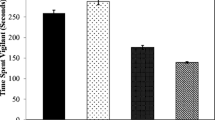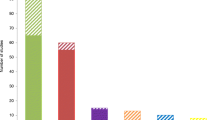Abstract
Brown hare populations (Lepus europaeus) are in decline throughout Europe since the 1960s, and numerous impact factors have been discussed in the literature. Although landscape fragmentation by roads is assumed to be one potential factor, the effects of roads on brown hare populations are poorly understood. We studied three potential effects of roads on brown hares asking: (1) Do roads affect the spatial distribution of hares due to disturbance effects? (2) Does road network density affect hare abundance due to barrier effects? (3) Does road network density affect road mortality rates in hare populations? The study is based on harvest statistics and spotlight taxations in Canton Aargau, Switzerland and was conducted at three different spatial scales. Spatial distribution was studied in plots established in varying distances parallel to roads, effects on abundance were analysed on the basis of raster grids, and road mortality was studied on the level of hunting districts. We show that (1) hares avoid the proximity to roads and prefer large non-fragmented areas over small isolated patches. (2) The density of freeways, federal and main roads has a negative effect on hare abundance. The density of unpaved field tracks has a positive effect probably because vegetation at field tracks contributes to the diet spectrum. (3) Effects of road network density on road mortality rates could not be shown, although road mortality has increased since the 1990s. We conclude that in debilitated populations, roads act as threatening factor for brown hare. We recommend establishing large un-dissected areas as a new category of wildlife refuge and to protect these areas from being further fragmented.







Similar content being viewed by others
References
Ahrens M, Kottwitz S (1997) Feldhasenprojekt Sachsen-Anhalt: Ergebnisse der Felduntersuchungen. Beitr Jagd-und Wildforsch 22:49–62
Barnes RFW, Tapper SC (1985) A method of counting hares by spotlight. J Zool 206:273–276
Barnes RFW, Tapper SC, Williams J (1983) Use of pastures by brown hares (Lepus europaeus). J Appl Ecol 20:179–186
Brassel P, Brändli UB (1999) Schweizerisches Landesforstinventar. Ergebnisse der Zweitaufnahme 1993–1995. Eidgenössische Forschungsanstalt für Wald Schnee und Landschaft (WSL). Bundesamt für Umwelt Wald und Landschaft (BUWAL), Bern
Bresinski W (1976) Weather conditions vs. European hare population dynamics. In: Pielowski Z, Pucek Z (eds) Ecology and management of European hare populations. Polish Hunting Association, Warsaw, pp 105–114
Bresinski W (1983) The effects of some habitat factors on the spatial distribution of a hare population during the winter. Acta Ther 28(29):435–441
Bühl A, Zöfel P (2005) SPSS 12. Einführung in die moderne Datenanalyse unter Windows, 9. Auflage. Pearson Studium, Munich
Dingerkus SK, Montgomery WI (1977) The distribution of the irish hare (Lepus timidus ibernicus) in Northern Ireland and its relationship to land classification. Gibier Faune Sauvage 14:325–334
Edwards PJ, Fletcher MR, Berny P (2000) Review of the factors affecting the decline of the European brown hare, Lepus europaeus (Pallas, 1778) and the use of wildlife incident data to evaluate the significance of paraquat. Agric Ecos Env 79:95–103
Eskens U, Kugel B, Bensinger S, Bitsch N (1999) Untersuchungen über mögliche Einflussfaktoren auf die Populationsdichte des Feldhasen. Zeit Jagdw 45:60–65
Fickel J, Lieckfeldt D, Pitra C (1999) Analyse der genetischen Diversität und Struktur in benachbarten Populationen des Feldhasen (Lepus europaeus, Pallas, 1778). Zeit Jagdw 45:230–237
Frylestam B (1980) Utilization of farmland habitats by European hares, Lepus europaeus, in southern Sweden. Swed Wildlife Res Viltrevy 11:449–464
Frylestam B (1981) Studies on the European hare XXXVII. Estimating by spotlight the population density of the European hare. Acta Ther 26:419–427
Glitzner I, Beyerlein P, Brugger C, Egermann F, Paill W, Schlögel B, Tataruch F (1999) Literaturstudie zu anlage- und betriebsbedingten Auswirkungen von Strassen auf die Tierwelt. Endbericht. Erstellt im Auftrag des Magistrats der Stadt Wien, Abteilung 22-Umweltschutz. ’G5“-Game-Management, Graz, 178 S.
Hartl GB, Suchentrunk F, Willing R, Grillitsch M (1989) Biochemical-genetic variability and differentiation in the brown hare (Lepus eruopaeus) of lower Austria. Wiener Tierärztliche Monatsschrift WTM 76:279–284
Hell P, Plavý R, Slamečka J, Gašparík J (2004) Losses of mammals (Mammalia) and birds (Aves) on roads in the Slovak part of the Danube Basin. Europ J Wild Res 51(1):35–40
Hoffmann D (2003) Populationsdynamik und -entwicklung des Feldhasen in Schleswig-Holstein im Beziehungsgefüge von Klima, Prädation und Lebensraum. Diss Univ Trier
Illner H (1992) Effects of roads with heavy traffic on grey partridge (Perdix perdix) density. Gibier Faune Sauvage 9:467–480
Jenness Enterprises (2005) Random point Generator 1, GIS-Tool ranpts.avx, Arizona, USA. Available from: http://www.jennessent.com/arcview/random_points.htm (accessed October 2006)
Köhler W, Schachtel G, Voleske P (1996) Biostatistik. Springer, Berlin, p 285
Langbein J, Hutchings MR, Harris S, Stoate C, Tapper SC, Wray S (1999) Techniques for assessing the abundance of brown hares Lepus europaeus. Mamm Rev 29(2):93–116
Lewandowski K, Nowarowski JJ (1993) Spatial distribution of brown hare Lepus europaeus in habitats of various types of agriculture. Acta Ther 38(4):435–442
Lundström-Gilliéron C, Schlaepfer R (2003) Hare abundance as an indicator for urbanisation and intensification of agriculture in Western Europe. Ecol Mod 168:283–301
Merrigi A, Alieri R (1989) Factors affecting brown hare density in northern Italy. Ethol Ecol Evol 1(3):255–264
Ninov N (1990) Der Einfluss einiger ökologischer Faktoren auf die Dynamik der Hasenbesätze in Bulgarien. Beitr Jagd-und Wildforsch 17:136–140
Pegel M (1986) Der Feldhase im Beziehungsgefüge seiner Um- und Mitweltfaktoren. Schriften des Arbeitskreises Wildbiologie und Jagdwissenschaft 16, Giessen
Pépin D, Angibault JM (2006) Selection of resting sites by the European hare as related to habitat characteristics during agricultural changes. Europ J Wildl Res 53:183–189
Pielowski Z (1990) Über die Abhängigkeit der Besatzdichte und anderer Populationsparameter des Hasen von der Agrarstruktur und landwirtschaftlichen Aktivitäten. Beitr Jagd-und Wildforsch 17:147–156
Pfister HP (1984) Raum-zeitliche Verteilungsmuster von Feldhasen Lepus europaeus Pallas in einem Ackerbaugebiet des Schweizerischen Mittellandes. Diss Univ Zurich
Pfister HP (1995) Die Feldhasen Situation in der Schweiz. In: Hare. International Symposium Czempin 1992, Warszawa, pp 21–42
Pfister HP, Kohli L, Kästli P, Birrer S (2002) Feldhase Schlussbericht 1991–2000. Bundesamt für Umwelt, Wald und Landschaft BUWAL (eds) Schriftenreihe Umwelt 334, Berlin
Reichlin T, Klansek E, Hackländer K (2006) Diet selection by hares (Lepus europaeus) in arable land and its implications for habitat management. Europ J Wild Res 52(2):109–118
Reynolds JC, Trapper SC (1995) Predation by foxed Vulpes vulpes on brown hares Lepus europaeus in central southern England, and its potential impact an annual population growth. Wildl Biol 1:145–158
Rimathé R (1977) Zur saisonalen Abundanzdynamik des Feldhasen (Lepus europaeus Pallas, 1978) im Schweizerischen Mittelland. Diss Univ Zurich
Roedenbeck IA, Fahrig L, Findlay CS, Houlahan J, Jaeger J, Klar N, Kramer-Schadt S, Van der Grift E (2007) The Rauischholzhausen-Agenda for road ecology. Ecol Soc 12(1):11 http://www.ecologyandsociety.org/vol12/iss1/art11/
Schröpfer R, Nyenhuis H (1982) Die Bedeutung der Landschaftsstruktur für die Populationsdichte des Feldhasen (Lepus europaeus Pallas, 1778). Z Jagdw 28:213–231
Smith RK, Vaughan Jennings N, Harris S (2005) A quantitative analysis of the abundance and demography of European hares Lepus europaeus in relation to habitat type, intensity of agriculture and climate. Mamm Rev 35(1):1–24
Spittler H (1987) Zur Ursache des sprunghaften Streckenrückgangs des Feldhasen (Lepus europaeus Pallas, 1778) in den Jahren 1978 und 1979. Zeit Jagdw 33:175–184
Strauß E, Pohlmeyer K (1997) Methodische Probleme bei der Scheinwerfertaxation zur Ermittlung der Feldhasenbesätze. Beitr Jagd-und Wildforsch 22:159–164
Strauß E, Pohlmeyer K (2001) Zur Populationsökologie des Feldhasen. NUA-Semin Ber 7:5–20 http://www.nua.nrw.de/nua/var/www/oeffentl/publikat/pdfs/sb07/02strauss.pdf
Tapper SC, Barnes RFW (1986) Influence of framing practice on the ecology of brown hare (Lepus europaeus). J Appl Ecol 23(1):39–52
Van der Zande AN, Ter Keurs WJ, Weijden WJ (1980) The impact of roads on the densities of four bird species in an open field habitat - evidence of a long-distance effect. Biol Cons 18:299–321
Van Wieren SE, Wiersma M, Prins HHT (2006) Climatic factors affecting a brown hare. Lutra 49(2):103–110
Acknowledgements
We are especially grateful to all hunters and volunteers who conducted spotlight taxations in the field. Special thanks to the cantonal administration (Bureau for Hunting and Fishery) for an exemplary cooperation and extraordinary support. The AGIS-coordination centre provided all GIS-data. I. Roedenbeck was funded by a grant of the German Environmental Foundation (DBU AZ 20004/712). The experiments comply with the current laws of the country in which they were performed.
Author information
Authors and Affiliations
Corresponding author
Additional information
Communicated by W. Lutz.
Rights and permissions
About this article
Cite this article
Roedenbeck, I.A., Voser, P. Effects of roads on spatial distribution, abundance and mortality of brown hare (Lepus europaeus) in Switzerland. Eur J Wildl Res 54, 425–437 (2008). https://doi.org/10.1007/s10344-007-0166-3
Received:
Revised:
Accepted:
Published:
Issue Date:
DOI: https://doi.org/10.1007/s10344-007-0166-3




